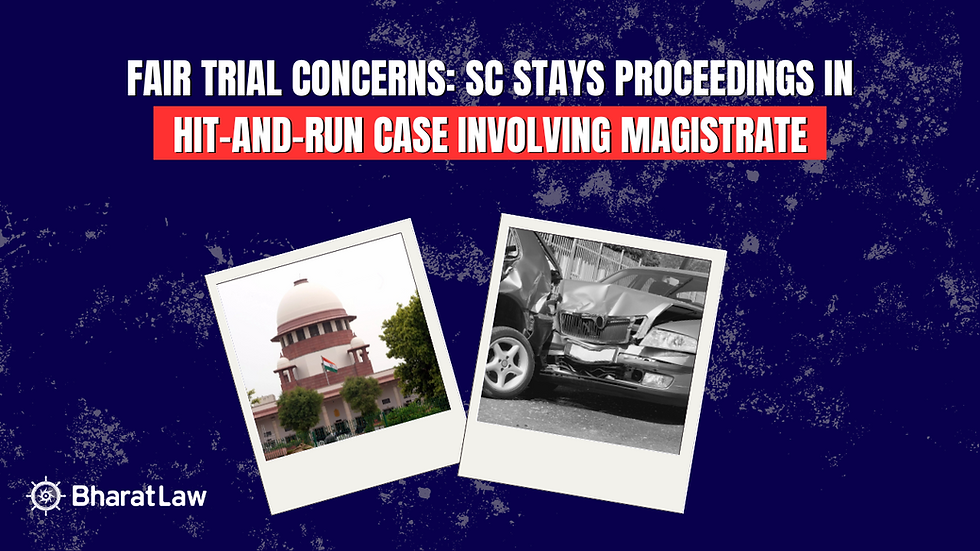Medical Negligence Must Be Proven Beyond Reasonable Doubt: Supreme Court Clarifies in Kamineni Hospitals Case
- Chintan Shah

- Apr 24
- 4 min read
Summary of the Judgment
Case Name: The Managing Director, Kamineni Hospitals v. Peddi Narayana Swami & Anr.
Date of Judgment: 22nd April 2025
Judges: Hon'ble Mr Justice B.R. Gavai and Hon'ble Mr Justice Augustine George Masih
Acts and Sections: Consumer Protection Act, principles of medical negligence
Cited Judgments: References to APSCDRC and NCDRC decisions
Introduction
The Supreme Court of India, on 22nd April 2025, rendered its decision in The Managing Director, Kamineni Hospitals v. Peddi Narayana Swami & Anr., addressing critical issues surrounding vicarious liability in medical negligence claims and the quantification of compensation under consumer protection law.
This judgment, delivered by Hon'ble Mr Justice B.R. Gavai and Hon'ble Mr Justice Augustine George Masih, examines not only the responsibility of healthcare institutions for the acts of their employees but also the method of assessing fair compensation in cases involving the loss of young lives.
Background
The case stemmed from a tragic incident where the complainant's 27-year-old son, a B.Tech graduate working at a soap factory, died following treatment at Kamineni Hospitals. The Andhra Pradesh State Consumer Disputes Redressal Commission (APSCDRC) initially found the hospital and the attending doctor negligent, awarding Rs. 20 lakhs in compensation, a decision upheld by the National Consumer Disputes Redressal Commission (NCDRC).
The hospital challenged these findings before the Supreme Court, contending that:
No medical literature or expert evidence substantiated the negligence.
Due care and standard medical practices had been observed.
The compensation awarded was excessively high and unsupported by documentary evidence.
Key Legal Issues
The Supreme Court had to consider two primary questions:
Whether the hospital and its doctors could be held liable for medical negligence without expert corroboration.
Whether the quantum of compensation awarded by NCDRC was justified.
Court's Reasoning
1. On the finding of negligence:
The Court reiterated the settled principle that medical negligence must be assessed based on whether a "reasonably competent practitioner" would have acted similarly in the circumstances. Quoting from the judgment, "Once a reasonable competent practitioner had taken caution and due care is observed, the guilt of medical negligence cannot be said to be made out against the doctor as well as the hospital."
However, upon scrutinising the evidence, the Court found ample material to affirm the earlier findings of negligence. Hon'ble Mr Justice Augustine George Masih observed:
"There is ample evidence as well as records to indicate that there was indeed medical negligence at the end of the Appellant and Respondent No.2."
Thus, the findings of APSCDRC and NCDRC were upheld in respect of liability.
2. On quantum of compensation:
The appellant further argued that Rs. 20 lakhs was disproportionately high. The Supreme Court approached the matter pragmatically, considering the deceased's age, educational qualifications, and earning potential. The Court remarked:
"The son of the complainant was 27 years of age at the time of his death, which is the prime age when a person starts his career and has his whole life to look forward to."
The deceased's modest initial earnings were not deemed a deterrent to his future potential. The Court acknowledged the broader impact of the young man's death on his family, who relied on him both emotionally and financially.
However, the Court made a calibrated modification. It reduced the liability of the hospital from Rs. 15 lakhs to Rs. 10 lakhs, directing that the amount already deposited with accrued interest be disbursed to the complainant.
As the Court succinctly put it:
"We are thus of the considered view that the amount of Rs.10 lakhs as stands deposited in this Court by the Appellant along with the accrued interest thereon would serve the interest of justice."
The compensation of Rs. 5 lakhs imposed on the attending doctor, Dr. J.V.S. Vidyasagar, was left undisturbed as he had accepted the decision and already deposited the requisite sum.
Significance of the Judgment
This decision reinforces critical legal principles:
Vicarious liability of hospitals: Institutions must maintain stringent standards and practices, as they can be held accountable for the acts of their medical staff.
Necessity of evidence: While expert testimony strengthens a case, the existence of documentary records and treatment protocols can suffice for establishing negligence.
Compensation assessment: Courts will factor in not just present earnings but future prospects, educational background, and family dependency when awarding compensation.
Judicial sensitivity: The Court displayed nuanced sensitivity towards balancing the loss suffered by the victim's family and the liability imposed on the institution.
Conclusion
The Supreme Court's judgment in The Managing Director, Kamineni Hospitals v. Peddi Narayana Swami & Anr. is a timely reminder of the high standard of care expected in medical services and the judiciary's increasing willingness to uphold patient rights under consumer protection laws.
By carefully upholding the finding of negligence while slightly moderating the compensation, the Court struck a balance between justice to the bereaved family and fairness to the healthcare provider. It underscores the principle that "the interest of justice" must guide judicial interventions in cases of medical negligence.
In the realm of consumer protection law and medical jurisprudence, this ruling will likely be cited as an authoritative precedent for years to come.



Comments